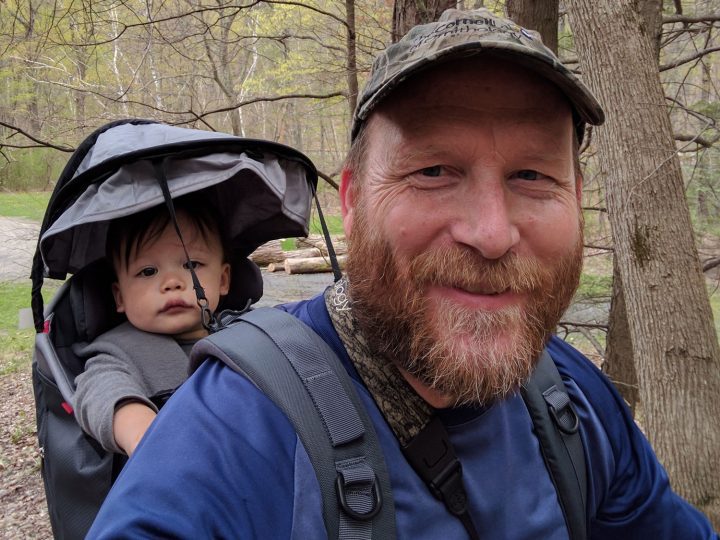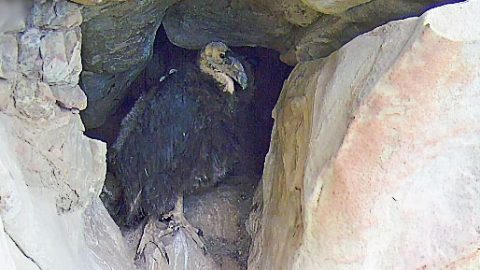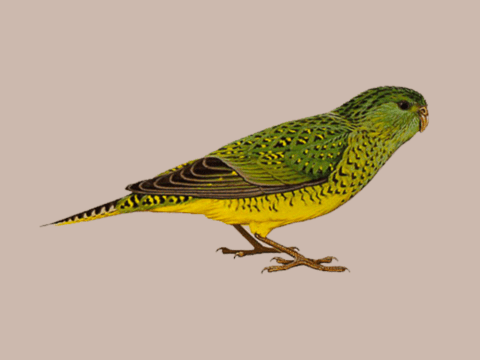Soaring in Circles: Two Road Trips to See California Condors, Thirty Years Apart
By Hugh Powell
June 12, 2017
From the Summer 2017 issue of Living Bird magazine. Subscribe now.
In late July of 1981, my father came home and asked me and my younger brother, Giles, if we wanted to go to California to look for condors. Be warned, he said: “It will be a knock-down, drag-out, no-holds-barred birding adventure with no concessions for kiddies.”
We said yes.
That Saturday morning, we got in our Chevy Suburban and my father drove 925 miles in one day to Mt. Pinos, California, one of the most reliable condor lookout points remaining, from our home at Holloman Air Force Base in New Mexico.
At the time, as a 12-year-old kid, I thought we were just going on another of my dad’s adventures. I didn’t appreciate that he was seizing a moment, or that later in that same decade, these great vultures were going to vanish from the skies. Now I’m middle-aged, and condors are flying free once again, in 10 times their 1981 numbers. If not for the foresight of the Endangered Species Act, we would have lost this largest North American bird entirely.
After our trip, my father wrote in his bird journal, “I believe that by my death, the only remaining condors will be in zoos.” He’s going to be wrong about that.
But while California Condors are a spectacular success story, much like Bald Eagles and Peregrine Falcons, there’s one glaring difference—we haven’t really gained the bird back. Their number-one problem—poisoning from lead ammunition—has yet to be solved. Even with the Endangered Species Act, the bird is still doomed, not to extinction but to constant maintenance, and always vulnerable to political vicissitudes that might end the recovery program.
“If you had asked me, ‘Is it worth spending however many millions of dollars on this species?’ I don’t know,” says Noel Snyder, who led the condor recovery program for the U.S. Fish and Wildlife Service during a crucial period in the early 1980s. “I’m very fond of condors and in some sense I’m very glad. But if it doesn’t go any farther than right now, basically you haven’t saved the bird.”

We had only been in California for about 18 hours when we saw ours. We had spent the night in the back of the Suburban and by 9 a.m. we were on the 8,800-foot summit of Mt. Pinos. Below us, canyon slopes stood like great chevrons with gray-green chaparral spreading over them.
My father was an Air Force fighter pilot and had eyes like a bird of prey. He picked up a dot over the sides of Mount Able. “Maybe 4, 5 miles,” he wrote later, in his daily bird journal. The two main confusion species were Turkey Vultures and Cessna twin-engine aircraft.
This dot was large, flat-winged, and so steady in the air it seemed not to be moving. “We watched it and said, ‘Well, could it be, might it be? It’s not flapping,’” my father recalls. “And all of a sudden it took a big double dip”—wings bending up and back down again, wingtips almost touching—“which is kind of a distinctive flight mode for the condor, and it kept coming slowly but surely.” That was the only wingbeat we ever saw it take.
After about 20 minutes the condor came right over the top of us. A little bird was harassing it the way a Red-winged Blackbird harries a crow, except this little bird was a Red-tailed Hawk.
I remember the condor’s massive wings filling the view of my 7×35 binoculars. The fingered primaries curved upward as clear California air rushed past the wingtips, holding the bird aloft. The white triangles in the underwing gleamed in the light, with just a few black feathers mixed among them. The bird wore no wing tags, because no condors at that time had ever been tagged. Today, they all are.

Very few people in 1981 recognized lead poisoning as a problem for California Condors, and nobody had any evidence. Conventional wisdom still held that condors were too big, too slow to reproduce, too dependent on large game. They were a “senile species,” according to one account, and the writing had been on the wall ever since the mammoths had disappeared. Condor recovery consisted of watching them from a distance and trying to preserve large tracts of wilderness so they could be left alone.
Things started to change in 1980, when Snyder took the helm of the recovery program. He wanted to use new technology to track where condors went and to breed them in captivity. But the team had yet to gain permission for the work, and there was a tooth-and-nail battle going on over whether captive breeding was a viable tactic or a last insult to a doomed species.

Nobody even knew how many condors were left until 1982, when a California Polytechnic professor named Eric Johnson started paying attention to molt patterns. The slow-growing primary feathers created distinctive wing outlines that could be used to identify individuals, much the way humpback whales are catalogued by patterns in their tail flukes. By arming students and volunteers with telephoto lenses and then carefully matching up hundreds of black-and-white prints, the team determined that just 21 condors remained in the wild.
“All of a sudden we knew how many condors there were and it was less than everyone had thought,” Snyder says. The low number helped gain approval for radio-tracking. Though the goal was to learn about condor movements, Snyder says the most important thing radio tags did was lead the team to dead ones.
In 1984, a radio tag led researchers to the body of IC1, the first California Condor known to die of lead poisoning. The next year, two more birds died from lead. There was little else to be done but start building up a captive population.
At the time, no one knew whether it would even be possible to breed California Condors in captivity, so Snyder had begun working with Andean Condors, for practice. By the early 1980s, “we knew that Andean Condors breed like chickens,” he says, and it turned out that California Condors did too, often doubling the yearly output that a wild pair could produce on its own. The team caught the last wild bird on Easter Sunday, 1987. My father’s prediction had come true: for the first time in at least 10,000 years, no condors flew over California.
By 1993 captive breeding had grown the population past 50 individuals, and by 1998 it passed 150. The recovery program still had lots of work to do, such as getting condors properly socialized to each other and unattached to humans, but the imminent prospect of extinction had passed.
What remained was lead.
“If they’re in the wild long enough, they’re going to get lead exposure.” That’s how Myra Finkelstein sums up the problem condors face. Finkelstein runs a lab at the University of California, Santa Cruz, that tests blood samples from wild condors. In the first 14 years after the recovery team began releasing captive-bred birds in 1997, biologists tested 150 different condors for lead a total of 1,154 times. What they found led Finkelstein to publish a paper titled “Lead poisoning and the deceptive recovery of the critically endangered California Condor.” Almost half of all free-flying condors had at some point developed lead levels so high that they needed to be brought to a zoo for emergency treatment. In some years, nearly 9 out of every 10 wild condors showed elevated lead levels.
Lead doesn’t build up in the food chain, or bioaccumulate, the way pollutants like DDT do. That means a condor can’t get lead poisoning just from eating a lead-poisoned animal—it has to consume the lead fragment itself. Unfortunately, it doesn’t take much: lead toxicity is measured in billionths of a gram. The snowstorm of flakes that a bullet sheds as it enters a deer, wild boar, or other animal’s body provides more than enough.
Bullets are almost pure lead, Finkelstein says, “so even a tiny fragment, if it gets in their digestive system and leaches out, can be enough to poison a condor.”
It’s tragic that condors don’t get better with age at avoiding lead. They’re very good at finding carcasses, visiting an estimated 150 per year, but they have no way of learning which ones have been shot. Old veteran condors are just as vulnerable to lead poisoning as a fresh fledgling is.
Because lead poisoning is so direct, tracing it back to its source is fairly easy. By measuring two isotopes of lead, Finkelstein can create something akin to a fingerprint that matches condor blood samples to environmental sources—it’s the same process used to trace lead contamination in homes. With condors, years of research have shown that the animals almost always get their lead exposure from ammunition. Finkelstein’s instruments can unequivocally distinguish between different sources of lead, such as bullets versus old lead paint.
Watch a Condor Chick Grow Up
Her evidence led to a 2008 ban on lead ammunition for big-game hunters in California’s condor country. But it’s been hard to enforce, and there are loopholes: lead bullets are allowed when euthanizing livestock and for controlling “nuisance” animals like coyotes and ground squirrels—all of which are on the condor’s menu.
More On Birds Coming Back From the Brink
As a result, condors showed no drop in lead poisoning after the 2008 ban—a result that pro-lead factions have used to argue for lifting the ban, perceived by some as unfairly scapegoating hunters. In 2013 the lead ammunition ban was expanded to cover all types of hunting and will include the entire state by 2019.
For Finkelstein, lead is a much larger public health issue. “As a society we have recognized that lead is toxic for a very long time, and gotten lead out of paint, and gotten lead out of gas,” she says. Alternatives to lead ammunition are no more anti-hunter than unleaded gas is anti-car, she says: “Changing from lead in gasoline didn’t mean you couldn’t drive your car. It just meant you had to use something else in your tank.”
“It really seemed to me that this was a very solvable problem,” Snyder recalls thinking after the three lead poisonings of the 1980s. “But nobody anticipated how hard the politics would be.”
Meanwhile, the recovery program goes on. Condors continue to breed in captivity, and increasingly in the wild. The recovery team toils to follow radio- tagged birds, set out lead-free carcasses, sweep nests for trash, check eggs for fertility, and capture each of the more than 250 free-flying birds to test for lead twice a year. According to exposure rates in Finkelstein’s 2012 paper, a typical year would see at least 175 of those birds developing elevated lead levels. “Even though I had been working with the data for years, it was still shocking,” Finkelstein says. “These birds are acutely poisoned all the time.”
What if the lead problem could be solved? Finkelstein has run the numbers: “Even if you just got rid of 80 percent of lead poisoning, the population would start increasing, and you would have a positive population growth rate, even without releasing birds.”




My dad had budgeted three days to wait for condors on Mt. Pinos. After one buzzed us before lunchtime on the first day, he deployed his contingency plan: head to Yosemite for his lifer Black Swift and Hermit Warbler. These landscapes—Mojave, Ventura, Sequoia, Yosemite—these were what crystallized in my mind as a boy going on adventures. On our way home, my father took a detour in Arizona for Violet-crowned Hummingbird, and then drove us home all night, through pelting thunderstorms, so we wouldn’t have to stay in a motel.
I remember watching his face in the rearview mirror. He was staring out into the raindrops and leaning over the steering wheel to keep himself awake. He was 40 years old—younger than I am today. I had total confidence in this man, who spent his workdays flying faster than the speed of sound. We had seen condors together—a bird that in the adult world was in crisis, but in my world had been almost a sure thing ever since my father had decreed we would go find it.
I didn’t know it then, but the whole reason we had taken this abrupt vacation was a shakeup in his squadron, a kink in his career trajectory he was dismayed to find he could not change. Until then, my father had been an Eagle Scout; a math whiz; a state-champion football player; a rock climber; a war veteran; a knockdown, drag-out birder.
He kept leading us on adventures, switching to small-boat sailing when the Air Force moved us to Florida a couple of years later. But somewhere in this period was a high-water mark, after which I realized birding might not, after all, be the second-coolest activity in the world after flying jets. And that vulnerability is not reserved only for the weak or the small, but can settle its heavy weight anywhere, even onto the largest wings on the continent.

Thirty-two years later, I returned to California to accompany four condor biologists on a nest check at the Hopper Mountain National Wildlife Refuge, just 20 miles from Mt. Pinos. We hiked through thick chaparral as a hot wind barreled up the slopes and flung fine dust in our eyes.
We stopped at a sheer fin of sandstone with an almond-shaped cave perhaps 50 feet below the ridge. In that alcove, tucked deep in the cool shadows, lay a single egg. Biologists Joseph Brandt of the U.S. Fish and Wildlife Service, and Jenny Schmidt of the L.A. Zoo, put on climbing gear and rappelled down to check the egg.
As we approached, a condor sailed up the canyon toward us, its big body impervious to the buffeting winds. Just before he came overhead he stalled and turned on the air, his great finger-primaries spread against the blue, his legs dangling roughly below him. Rotating slowly in spite of gravity and wind, he completed the circle and began an arc back toward the valley, then abruptly dropped below the ridge and onto the nest entrance. His wing tag was yellow, meaning “200,” and bore the number 37.
This was male #237, at 23 pounds a big bird even for a condor, and “always really standoffish,” according to Brandt, who notes every condor has its own personality. This male and his mate, female #255, had both hatched in captivity in 2001 and were released the following year. This was their fourth nesting attempt each.
Brandt is 6’2”, thick-trunked as a sequoia, with blond dreadlocks. When he arrived at the cave entrance and unclipped from the rope, he didn’t have to bend down to walk in. Schmidt came after, carefully placed the egg in a black bag to block the light and checked it with a flashlight: it was fertile.
Later that month, the pale blue-white egg cracked from within and a chick pushed its way into the world. The little gray nestling became condor #717, a female who is still flying free today.
All About Birds
is a free resource
Available for everyone,
funded by donors like you
American Kestrel by Blair Dudeck / Macaulay Library









